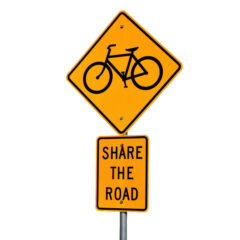This page starts with a comparison of the risk involved in cycling to the risks when using other modes of transport. The risk of doing ultra-distance cycling is then compared to doing other sports and recreational activities.

Page Contents:
Risk Level of Using a Bicycle for Transport
Risk levels of different modes of transport are easiest to compare when given as deaths per billion km traveled because absolute numbers of deaths per transport mode are virtually meaningless without comparing them to overall usage rates. A typical rate for cyclists is about 25 deaths per billion km in the UK and 11 to 15 in northern Europe and Scandinavia (see this EU document and this website). This compares to about 2-3 deaths for people in cars and less than 0.5 for people using public transport traveling the same distance. Motorbikes are by far the most dangerous form of transport, with rates of up to 100 deaths per billion km traveled.
Not many countries estimate the number of cyclists on their roads or the distances ridden, so comparative rates for other countries are not available. However, we do know that overall rates of road deaths vary widely between countries (see the table at Wikipedia or this map of Europe), with less wealthy countries having risk levels 2 to 4 times as high as more wealthy countries in the same region (which may be explained by differences in road infrastructure, vehicles used and health care). I therefore use an estimate for cyclists of between 10 and 40 deaths per billion km ridden in most of Europe, North America and Australasia, which is where most bikepacking races are held and the participants live.
The objective risk of cycling is therefore very low, with only 1 cyclist dying for every 25 to 100 million kms ridden (= 1 billion / 40 or 10, depending on the country). In contrast to this small risk, cycling has massive benefits for overall health, with cyclists estimated to have a life expectancy that is 0.5 to 2 years longer than people who do not exercise (see this, this and this article).
In summary, the health benefits of cycling far outweigh the very minor risks for average cyclists. So, what about the risk involved in participating in ultra-distance cycling races?
Risk Level in Ultra-Distance Bikepacking Races
The Annus Horribilis of 2017

Cyclist safety in bikepacking races was an extremely tragic and hot topic in 2017 because participants in three major road-cycling bikepacking races died when hit by vehicles. We first lost a great ambassador and developer of our sport when Mike Hall passed away during the 2017 Indian Pacific Wheel Race in Australia (read my tribute to him), but the other two lives are equally important to their friends and families, with Eric Fishbein dying during the Trans Am Bike Race in the USA and the same fate befell Frank Simons in the Transcontinental Race No. 5, 2017 in Europe.
The bikepacking community was shocked by these 3 deaths, some races were cancelled (e.g., the Trans Afrika Bike Race), and some participants decided not to race due to safety concerns or loss of motivation to race. The objective risk level of competing in such events obviously did not change due to these incidents, but the perceived risk level greatly increased. No-one has ever tried to estimate the objective level of risk of this sport before, so here is an initial attempt.
Theoretcial Risk Level
The TCR is the most popular bikepacking race, so I use the case of an average participant in that event who is likely to cover about 265 km per day (see the Overall Results of the Transcontinental Race page). People in such events are almost all extremely experienced cyclists, and so are generally better bike handlers and more experienced at riding in a variety of traffic conditions than average cyclists, thereby slightly diminishing the chance of certain Types of Bike Crashes. The degree of risk can increase for cyclists suffering from Sleep Deprivation, but this should not be a major problem for someone doing 265 km per day.
Ultra-distance cyclists spend a lot more time riding in rural regions than do typical cyclists (a large proportion of whom are using the bike for transport in urban areas). There is some evidence that riding in rural areas is slightly riskier than riding in urban areas per km ridden due to the increased speed of traffic in rural areas (see this and this article).
Factoring in these positive and negative influences and being conservative, I update the range of 10-40 deaths per billion kms for more typical cyclists to be about 50 deaths per billion km ridden for ultra-distance cyclists, or one for every 20 million kms ridden. This is a very rough figure based on some major assumptions, but it provides something to use to compare the safety of this sport to the safety of other sports.
The degree of risk in sports and recreational activities is often measured in micromorts, which is the number of deaths per 1,000,000 exposures or days of activity. If 50 people die per billion km cycled then for people who cycle an average of 265 km per day we would expect about 13 deaths per 1,000,000 days of cycling (1,000,000 x 265 / 20 million = 13.25).
Depending on the event, ultra-distance bikepacking races may take 10 to 20 days to complete, although one third to one half of participants don’t reach the finish and on average those people only complete half of the distance (again, see the Overall Results of the Transcontinental Race page). This suggests a typical person who starts a bikepacking race like the TCR may spend an average of 12 days riding about 265 km per day before finishing the race or scratching. The associated risk accumulates every day, so we can estimate that 159 people out of every 1 million starters (13.25 x 12 = 159) are likely to die in a crash, or that we should expect 1 death for every 6,300 starters (1,000,000 / 159 = 6289).
How do these values for people doing bikepacking races (13 micromorts per day or 159 micromorts per event) compare to the risks involved in doing other activities?
Comparison to Other Activities & Sports

The baseline chance of dying from any cause is highly dependent on age and partly on gender (see here). For males in western Europe and North America, about two 30-year-olds die each day per million individuals, meaning 2 micromorts, rising to 6 micromorts per day at 45 years old and 23 for 60-year-old males. The extra theoretical risk of 13 micromorts per day when doing a bikepacking race therefore doesn’t appear to be too extreme.
Estimates for downhill skiing are less than 3 micromorts per day due to incidents on the slopes (see here). Estimates for running a marathon are about 8 micromorts (NY Times). The rate for people trekking in the Himalayas (not mountaineering) is 10 per day (see this article). For parachuting and scuba diving, the rate is about 5 to 10 micromorts per jump or dive. A BBC article on the topic concluded that “there seems to be some natural level of risk [of about 10 micromorts per activity] that people are prepared to take on for a challenging and exciting leisure activity, while still being reasonably sensible”.
It’s pleasing that the risk experienced during one day of a bikepacking race (estimated to be about 13 micromorts) may not be so different from doing these other sports and activities once. It is only when the risk accumulated due to the length of bikepacking races (estimated to be about 159 micromorts) is considered that that rate becomes more worrying.
The most comparable sport to bikepacking for which there is an ample amount of solid data is professional road cycling. I therefore analyzed data from the Tour de France and Giro d’Italia between the end of WWII until today, which is a total of 143 race editions (I didn’t include the Vuelta a España or other races because I couldn’t find sources with complete and reliable historical data about the race distances and number of participants). There have been six deaths in these races during that period (in 1952, 1967, 1976, 1986, 1995 & 2011, see Wikipedia). The hazards involved in doing intense races on closed roads are obviously quite different to riding at a more relaxed pace on open roads, but it is the level of risk that I am interested in comparing rather than the causes of the risks.
The statistics available on BikeRaceInfo.com suggest that racers rode a total of 113.6 million km in that time in those races (an average of 3,860 km per race, with 154 starters and 109 finishers). This suggest a risk level of 53 deaths per billion kms ridden. It’s important to note that I computed this value several weeks after deciding to use a value of 50 deaths per billion kms ridden as an estimate for bikepacking races. On average, participants starting one of these Grand Tours will ride 2,730 km, which means that they have a about a 144 in 1 million chance of dying during the race, which is not so different to the 159 micromorts predicted for starting a bikepacking race.
Observed Risk Level in Bikepacking Races
Unfortunately, the observed data from bikepacking races doesn’t totally agree with my theoretical predictions. Fewer than 800 people started the Transcontinental Race before Frank Simons died and fewer than 200 had started the Trans Am Bike Race when Eric Fishbein died. The Indian Pacific Wheel Race was in it’s inaugural edition, in which fewer than 100 people started, when Mike Hall died.
To compute meaningful statistics we need to define a population that also includes all Bikepacking Races regardless of whether someone has died in them or not. When doing so, the total size of the population may be about 3,000 people (it’s certainly above 2000 and is very unlikely to exceed 5000).
Even three tragic incidents doesn’t allow the observed risk level to be estimated very precisely, especially when we’re unsure what the size of the population is. If we do assume that the population is about 3000 and use this statistical tool then we can be 95% confident that the actual risk level is between about 200 and 3000 deaths per 1,000,000 starters, or 200 to 3000 micromorts per starter. This range doesn’t quite include the theoretically-determined value of 159.
The equivalent range based on the data from the Tour de France and Giro d’Italia is 53 to 314 micromorts per starter. Because these ranges overlap, we cannot say that there is enough data to conclude that doing a bikepacking race is more dangerous than doing a Grand Tour.
The activity that I found that has the most comparable observed risk level to that observed for doing a bikepacking race is BASE jumping (jumping off of a fixed object with a parachute). Research published in the Journal of Trauma states that 9 deaths were observed in an 11-year period in a popular area of Norway where over 20,000 jumps were made. This suggests a rate of 432 micromorts per jump, and a 95% confidence interval of about 200 to 800 micromorts.
At the extreme end of the scale of risky sports is high-altitude mountaineering. About 1 in 100 people who have done a mountaineering expedition in the Himalayas above 6,000 meters elevation have died, which is a rate of about 10,000 micromorts per expedition (see this article).
Alternative Forms of Ultra-Distance Cycling
Following the tragic incidents of 2017, some people hoped that it would be safer to do supported instead of unsupported bike races or to do races that primarily use dirt roads and trails instead of paved roads. Unfortunately, fatalities have also occurred in the main events in those categories: There were two deaths caused by collisions with vehicles in the most important supported ultra-distance cycling race, the Race Across America, in 2003 and 2005 (see this article). In addition, a rider participating in the Tour Divide mountain bike bikepacking race in the USA died in a collision with a car on a dirt road in 2010 (see this article ). I’m not trying to argue that all types of ultra-distance bike racing are excessively dangerous; I’m merely pointing out that there is not enough evidence to suggest that one type is safer or more dangerous than another.
I am in the process of trying to gather data from more ultra-distance cycling events (audaxes, supported ultracycling, bikepacking, etc.) to have more data to use to estimate the observed risk level, but for now no firm estimates or conclusions can be made.
Conclusion

All modes of transport have risks, but although the risk of cycling is higher than most forms of motorized transport, the health benefits more than offset the very minor increased risk level, thereby causing people who cycle to have an average life expectancy that is significantly longer than those who are sedentary. Evidence shows that accident rates for cyclists are lower in countries in which people cycle more often (e.g., see here), so one of the best ways to improve the safety of cyclists in general is to encourage more people to ride bikes on the road more often.
Bikepacking races are more about sport and recreation than transport, so the risk level should be compared to that of other sports instead of other modes of transport. My estimate for the degree of risk per km when doing a bikepacking race suggest that doing such races puts participants at a reasonable level of risk per day that is not much higher than other relatively safe sports and activities.
The theoretical risk of ultra-distance cycling does become greater than some other sports due to the length of the races causing the risk to accumulate, but it is still not extreme. Deaths due to collisions with cars have occurred in all forms of ultra-distance cycling, but 2017 was a particularly bad year for road-based bikepacking events with three tragedies, but there is still not enough data to make any precise estimates about the observed degree of risk. It should also be kept in mind that although many cyclist fatalities are caused by collisions with cars and often the driver is at least mostly to blame, drivers cannot be blamed for all such incidents; see the Causes & Types of Bike Crashes page.
Last significant page update: December, 2017
This page is in the Rider Health & Safety section. The next page in this section is:

